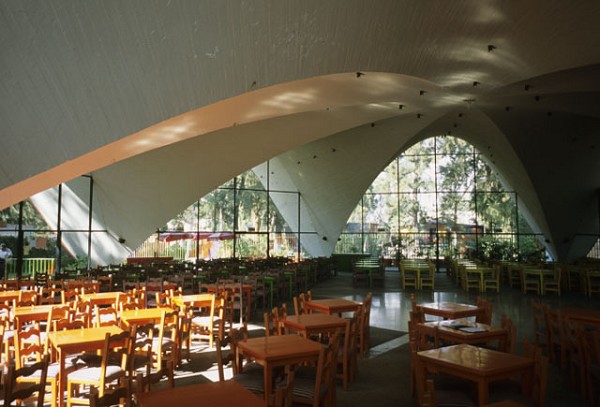

The outbreak of war in 1936 initially prevented Candela’s planned research trip to Germany, where he had intended to learn about the influence of the still young reinforced steel construction method on architectural design. The realization of Torroja’s spectacular draft for the »Hipódromo de la Zarzuela« racetrack was delayed, however, by the Spanish Civil War, which would lead to a remarkable turning point in Candela’s life. He studied the work of Eduardo Torroja, who became one of the first Spanish architects to experiment in the late 1930s with the hyperbolic paraboloid shell: a roof with regular curves in two directions, the shape of which is also referred to as a saddle roof.

After his graduation from the Universidad Politénica de Madrid, he deepened his knowledge at the Real Academia de Bellas Artes de San Fernando. He also repeated all the calculations step-by-step, and thus acquired a basic, self-taught understanding of the thin-shell construction method. Following the addition of architectural details (windows, doors, etc.), the structure remains the most prominent feature.Because thin-shell designs were not covered during his studies, Candela copied out articles from German and French technical journals by hand, and translated them into Spanish at home, word by word. It is at this point that the shell comes alive and is seen in its purest, most refined form. When the concrete had hardened to sufficient strength, the scaffolding and form boards were removed. With the form boards in place, and then the reinforcing steel laid on them the concrete could be cast by hand, one bucket at a time. The form boards for construction followed the path of the straight-line generators that formed the hypar surface.

He commented that this is "what makes (the shell) so graceful, the regularity and the proportion. Candela was pleased with the unique visual design of his support detail, where instead of a sharp V-shape, he formed it into a curve to give it continuity. To resist lateral thrusts, he linked adjacent footings with steel tie-bars, thus allowing the umbrella footings to carry only vertical loads. The V-beams are reinforced with steel, while the rest of the shell has only nominal reinforcing, not for added strength, but to address temperature effects and other properties of the concrete material that can cause cracking.Īt the supports, Candela anchored the V-beams into inverted umbrella footings, which cup the earth to prevent the shell from sinking into the soft Mexican soil. Structure and realisationĪs was his practice, at Xochimilco Candela used V-beams for groin stiffening, which was not visible, either from the inside or the outside, thus adding a bit of mystery to the educated observer of shell behavior. He had designed a few others before Xochimilco, but none so striking. The restaurant was not Candela's first groined vault. The groins are the valleys in the shell formed at the convergence of the intersecting hypars. Where the pavilion has two saddles, one in front of the other, the restaurant belongs to a type of shell structure called groined vaults. The Cosmic Ray Pavilion, Candela's first hypar shell, has curved edges just like those of the restaurant in Xochimilco. The groined vault consists of four intersecting hypars, a structure that he had not yet attempted.
#Xochimilco restaurant roof felix candela free#
The form of the shell was a play of the hypar with free curved edges, that is, the edges of the shell are parabolic and free of any edge stiffeners that would conceal the thinness of the shell. Faber had made a rough sketch that somewhat resembled the final form of the restaurant Candela liked the idea, so he took it and redesigned it into a more graceful shape. Candela's stimulus for the form of Los Manantiales Restaurant in Xochimilco, Mexico City came from Colin Faber, who was working with Candela at Cubiertas Ala.


 0 kommentar(er)
0 kommentar(er)
